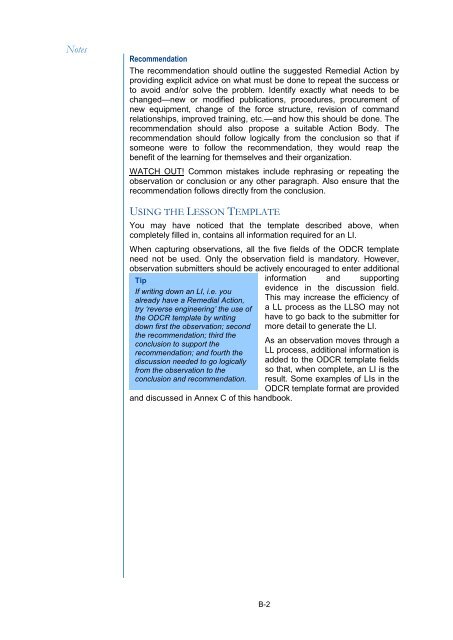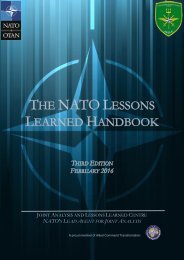JOINT ANALYSIS LESSONS LEARNED CENTRE NATO'S LEAD AGENT JOINT ANALYSIS
1ViofYb
1ViofYb
You also want an ePaper? Increase the reach of your titles
YUMPU automatically turns print PDFs into web optimized ePapers that Google loves.
Notes<br />
Recommendation<br />
The recommendation should outline the suggested Remedial Action by<br />
providing explicit advice on what must be done to repeat the success or<br />
to avoid and/or solve the problem. Identify exactly what needs to be<br />
changed—new or modified publications, procedures, procurement of<br />
new equipment, change of the force structure, revision of command<br />
relationships, improved training, etc.—and how this should be done. The<br />
recommendation should also propose a suitable Action Body. The<br />
recommendation should follow logically from the conclusion so that if<br />
someone were to follow the recommendation, they would reap the<br />
benefit of the learning for themselves and their organization.<br />
WATCH OUT! Common mistakes include rephrasing or repeating the<br />
observation or conclusion or any other paragraph. Also ensure that the<br />
recommendation follows directly from the conclusion.<br />
USING THE LESSON TEMPLATE<br />
You may have noticed that the template described above, when<br />
completely filled in, contains all information required for an LI.<br />
When capturing observations, all the five fields of the ODCR template<br />
need not be used. Only the observation field is mandatory. However,<br />
observation submitters should be actively encouraged to enter additional<br />
Tip<br />
If writing down an LI, i.e. you<br />
already have a Remedial Action,<br />
try ‘reverse engineering’ the use of<br />
the ODCR template by writing<br />
down first the observation; second<br />
the recommendation; third the<br />
conclusion to support the<br />
recommendation; and fourth the<br />
discussion needed to go logically<br />
from the observation to the<br />
conclusion and recommendation.<br />
and discussed in Annex C of this handbook.<br />
information and supporting<br />
evidence in the discussion field.<br />
This may increase the efficiency of<br />
a LL process as the LLSO may not<br />
have to go back to the submitter for<br />
more detail to generate the LI.<br />
As an observation moves through a<br />
LL process, additional information is<br />
added to the ODCR template fields<br />
so that, when complete, an LI is the<br />
result. Some examples of LIs in the<br />
ODCR template format are provided<br />
B-2



